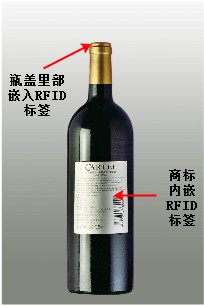1. RFID system composition and principle
1.1 System Composition
A most basic RFID system is generally composed of a chip that stores marker information, that is, an electronic tag (Tag), a reader for writing and reading out tag data (Reader, also known as a reader head) and an antenna. In order to be able to process label data, it is also necessary to have the corresponding computer system support.
(1) Electronic tag (Tag, that is, radio frequency card): is the core component of RFID, it is installed on the identified object, storing a certain format of electronic data, that is, detailed information about this object. Labels are similar to barcode symbologies in barcode technology, but except that they must be able to transmit stored information automatically or semi-automatically. The electronic tag consists of a tag antenna and a tag chip. A tag chip is a monolithic system (S0C) with wireless transceiver and storage functions, which stores encoded data in a conventional format to uniquely identify the attached object. It is the data carrier of the radio frequency identification system, with the ability to intelligently read, write and encrypt communications.

(2) Reader: It can automatically read the electronic data stored in the electronic tag in a contactless manner, and is the information control and processing center of the RFID system. There is a communication protocol between the reader and the electronic tag, and information is exchanged between each other. Whenever an object adhering to an electronic tag passes through its reading range, it emits radio waves to the tag, and then the tag sends back the object information it has stored, the whole process is non-contact.
(3) Antenna: Transmits an RF signal between an electronic tag and a reader. The antenna connected to the reader is generally made into a door frame form, placed in the channel entrance of the measured item, which on the one hand provides electrical energy to the passive electronic tag to transmit radio signals to activate the electronic tag; On the other hand, it also receives information emitted from electronic tags. Each electronic tag also has its own micro-shaped antenna for communicating with the reader.
1.2 How RFID Systems Work
A schematic diagram of how an RFID system works is shown in Figure 1. Usually the electronic tag is placed on the object, and the reader sends a certain frequency radio frequency signal through the antenna; When the electronic tag enters the radio wave receiving coverage of the reader, its micro-shaped antenna generates an induced current, and the electronic tag obtains energy to be activated and sends information such as data required for identification to the reader (the electronic tag demotes the instructions from the received RADIO frequency pulse to the control logic, and the control logic receives instructions to complete the storage, transmission of data or other operations); The reader receives the carrier signal from the electronic tag, demodulates and decodes the signal and sends it to the computer host for processing; The computer system judges the legitimacy of the label according to the logical operation, makes corresponding processing and control for different settings, and issues an instruction signal.

2, the advantages of RFID
RFID has the following advantages:
(1) Easy to read
The data is read without “contact”, without the need for a light source, and can even be carried out through the outer packaging. The effective recognition distance is large, and when the active label with the own battery is adopted, the effective identification distance can reach more than 30 meters.
(2) Fast recognition
As soon as the electronic tag enters the identification site, the reader can instantly read the information in it, and can process multiple electronic tags at the same time to achieve batch recognition.
(3) It is easy to achieve miniaturization and diversification of shapes
Electronic tags are not limited by size and shape in reading. It is small, easy to encapsulate, and has a variety of shapes (such as card-shaped, ring-shaped, button-shaped, pen-shaped, etc.), which can be hidden or embedded in most materials or products, making the marked goods more beautiful. It can be applied to different occasions and is very convenient to use.
(4) The memory capacity of data is large
Usually the largest data capacity of two-dimensional barcodes (PDF417), can only store a maximum of 2725 numbers, if it contains letters, the amount of storage will be less, electronic tags can be expanded according to the needs of users. At present, the electronic tag chips produced on the market also have the lowest amount of stored data in 17-bit binary numbers, which is far greater than the amount of data in the bar code. In the future, the amount of information required for items to be carried is getting larger and larger, and the data capacity will expand with the development of memory specifications, and the electronic tag will not be limited.
(5) Penetrating
RFID can read the label through non-metallic materials such as mud, dirt, paints, oils, wood, cement, plastic, water and steam when identifying, and does not necessarily have direct contact with the electronic tag carrier. Data transmission uses a higher frequency band, the use of radio principles to transmit signals, electronic tags can still be penetrating communication even when wrapped in paper, wood, plastic, etc. such as the above.
(6) Environmental resistance
RFID can also read data in a dark or dirty environment. It has a strong resistance to water, oil and medicines and other substances, unlike paper once dirty will not be seen, even in harsh environments can be used, the operating temperature can reach -25 °C ~ +70 °C, so the electronic tag Rui Feng De dirty, wet and harsh and other harsh environments are ideal for reading.
(7) Long service life and wide range of applications
The service life of electronic tags can be up to 10 years, read and write 100,000 times, no mechanical wear, no mechanical failure.
(8) Better security
The unique number of electronic tags allows for password protection for the read and write of stored data, as well as the addition of an anti-counterfeiting identifier through an encryption operation. As long as it is scanned by the network or the manufacturer’s anti-theft identification device such as a reader, it can immediately distinguish the authenticity of the product and have higher security.
(9) Cost
The price of electronic tags will decrease with the development of technology and the expansion of production scale.
3. The application of RFID in commodity anti-counterfeiting

The principle of anti-counterfeiting is: the commodity identification number (ID), that is, the anti-counterfeiting code (which is encrypted by hardware or software algorithms) is written in the RFID chip, which is unique in all aspects of production, sales and so on; The chip is made into an electronic tag, which is attached to the product, making it an integral part of the Product. When the electronic tag is “forced” to separate from the commodity, the “integrity” of the commodity is destroyed, the commodity is considered to have been “consumed”, and the security ends. In the above links, various technical means are used to ensure that this ID verification process is not forgeable and tampered with. If the verification mechanism is forged, counterfeit goods will appear; If the verification process is tampered with, it will cause the genuine product to be “falsified” and thus disrupt the market. In this way, in the whole process of commodity from production, circulation to consumption, there is only one commodity with unique verification means identified by a unique ID, so as to achieve the purpose of anti-counterfeiting. The identification ID data of the RFID electronic tag is read-only and cannot be changed. In order to prevent counterfeiters from using forged electronic tags with the same ID, a secret information “key” associated with the ID can also be written in the anti-counterfeiting tag to identify the uniqueness of the verification process. Therefore, the anti-counterfeiting tag ID is unique, the secret verification information in the chip is unique, and the strict encryption authentication mechanism can make the anti-counterfeiting technology effective for a long time.
Domestic people commonly used commodities, such as alcohol, cosmetics, medicine and health care products in some of the famous brands, counterfeit and shoddy goods appear in the market will seriously affect the credibility of these brand-name goods, affect the country’s economic construction, its anti-counterfeiting is very necessary. RFID anti-counterfeiting technology has broken through the previous anti-counterfeiting technology ideas, and has taken a new measure to make it difficult to forge, easy to identify, information feedback, password uniqueness, password confidentiality, one-time use and so on. The use of RFID technology anti-counterfeiting, compared with laser anti-counterfeiting, digital anti-counterfeiting, etc., its advantages are: each tag has a unique ID number, this unique ID is placed in the ROM when making the chip, can not be modified, Difficult to imitate; No mechanical wear, anti-fouling; The reader has a physical interface that is not directly open to the end user, ensuring its own security; In terms of data security, in addition to the password protection of electronic tags, the data part can be used to achieve security management with some algorithms; There is a process of mutual authentication between readers and electronic tags, etc.
4. Conclusion
Regardless of the way RFID anti-counterfeiting is applied, it is also necessary to ensure that the safety of the instrument is identified. Only in this way can it really play a role in anti-counterfeiting. At present, China’s RFID is mainly used in logistics management, medical field, monitoring and tracking management of goods and dangerous goods, baggage check-in of civil aviation and non-stop charges for roads and bridges. It can be predicted that the application of RFID will give birth to a huge market, is a new economic growth point, its potential and prospects will be very attractive. The unique advantages of RFID technology will form a huge industry in the world, which deserves attention in various fields.








InfoAsia Việt Nam trở thành nhà cung cấp dịch vụ phần mềm số hóa nhà máy sản xuất cho thương hiệu giày hàng đầu thế giới NEW BALANCE
Công ty TNHH Mây Tre Hà Linh
SAP ERP MES and IOT Project for FVIV Factor
Buwon Industry Co, Ltd
KANGLONGDA VIETNAM PROTECTION TECHNOLOGY COMPANY LIMITED
Shini Group
TA TING PLASTIC (HAI DUONG ) CO., LTD
CÔNG TY TNHH MTV BIÊN HOA SCM